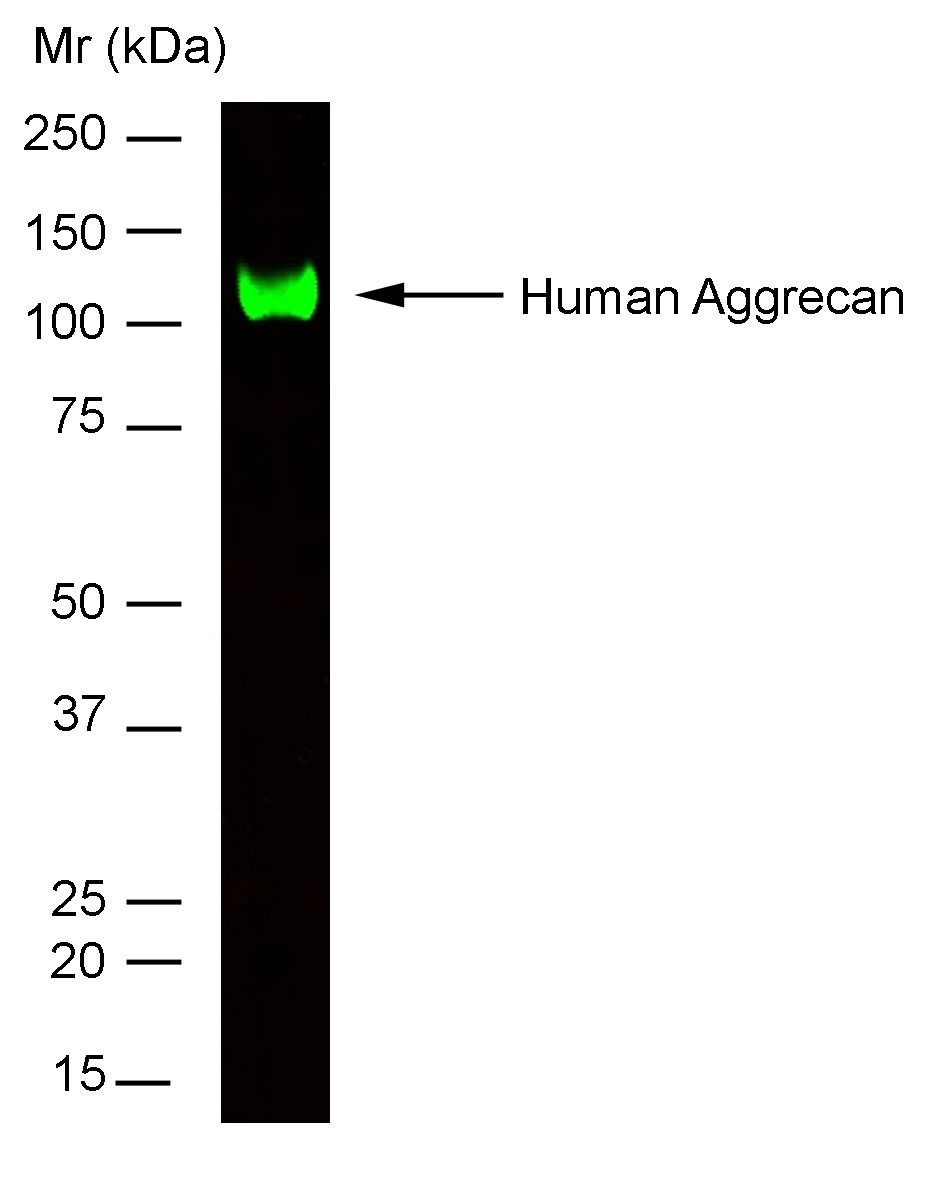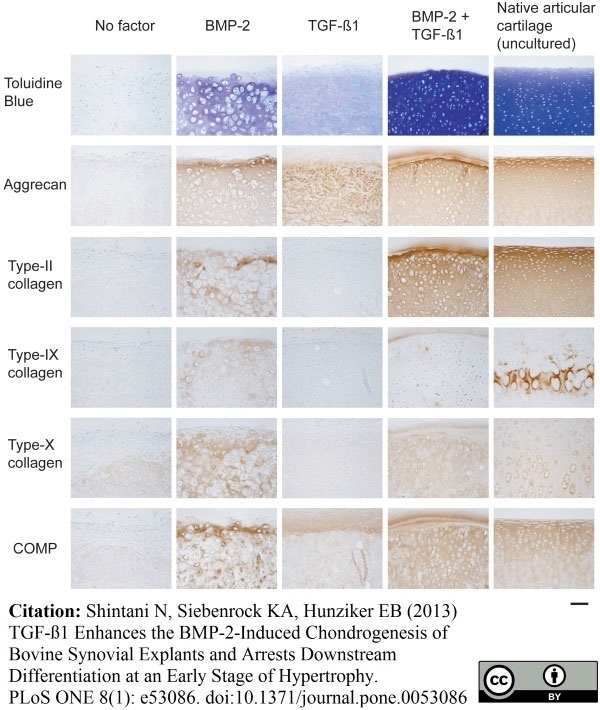Aggrecan antibody | 7D4


Mouse anti Human Aggrecan
- Product Type
- Monoclonal Antibody
- Clone
- 7D4
- Isotype
- IgG1
- Specificity
- Aggrecan
| Mouse anti Human Aggrecan antibody, clone 7D4 recognizes human aggrecan, a proteoglycan and member of the aggrecan/versican proteoglycan family, which forms a major component of the extracellular matrix (ECM) of both cartilage and the central nervous system (CNS). Using a panel of core protein-directed antibodies directed against human aggrecan, revealed the distribution of different aggrecan isoforms within the CNS, and sub-divided the isoforms into clusters 1-5 accordingly. highlighting a difference in the relative abundance of these isoforms when comparing brain and cartilage tissues (Virgintino et al. 2009). Mouse anti Human Aggrecan antibody, clone 7D4 recognizes epitopes within the N-terminal G1-IGD-G2 region of aggrecan, identified as a cluster 1 isoform. |
- Target Species
- Human
- Species Cross-Reactivity
-
Target Species Cross Reactivity Bovine Chicken Fish Rat - N.B. Antibody reactivity and working conditions may vary between species.
- Product Form
- Purified IgG - liquid
- Preparation
- Purified IgG prepared by affinity chromatography on Protein A from tissue culture supernatant
- Buffer Solution
- Phosphate buffered saline
- Preservative Stabilisers
- 0.09% sodium azide (NaN3)
- Carrier Free
- Yes
- Immunogen
- Purified human articular cartilage aggrecan
- Approx. Protein Concentrations
- IgG concentration 1.0mg/ml
- Fusion Partners
- Spleen cells from immunised Balb/c mice were fused with cells of the mouse NS1 myeloma cell line.
- Regulatory
- For research purposes only
- Guarantee
- 12 months from date of despatch
Avoid repeated freezing and thawing as this may denature the antibody. Storage in frost-free freezers is not recommended.
| Application Name | Verified | Min Dilution | Max Dilution |
|---|---|---|---|
| ELISA | |||
| Immunohistology - Frozen | |||
| Immunohistology - Paraffin | |||
| Immunoprecipitation | |||
| Western Blotting |
- Histology Positive Control Tissue
- Human cerebral cortex
References for Aggrecan antibody
-
Betre, H. et al. (2002) A two-step chondrocyte recovery system based on thermally sensitive elastin-like polypeptide scaffolds for cartilage tissue engineering
Engineering in Medicine and Biology 24th Annual Conference and the Annual Fall Meeting of the Biomedical Engineering Society EMBS/BMES Conference,: 829-30. -
Virgintino, D. et al. (2009) Differential distribution of aggrecan isoforms in perineuronal nets of the human cerebral cortex.
J Cell Mol Med. 13 (9B): 3151-73. -
Shintani, N. and Hunziker, E.B. (2011) Differential effects of dexamethasone on the chondrogenesis of mesenchymal stromal cells: Influence of microenvironment, tissue origin and growth factor.
Eur Cell Mater. 22: 302-20. -
Blosa, M. et al. (2013) Unique features of extracellular matrix in the mouse medial nucleus of trapezoid body--implications for physiological functions.
Neuroscience. 228: 215-34. -
Shintani N et al. (2013) TGF-β1 enhances the BMP-2-induced chondrogenesis of bovine synovial explants and arrests downstream differentiation at an early stage of hypertrophy.
PLoS One. 8 (1): e53086. -
Suttkus, A. et al. (2014) Aggrecan, link protein and tenascin-R are essential components of the perineuronal net to protect neurons against iron-induced oxidative stress.
Cell Death Dis. 5: e1119. -
Gaál B et al. (2014) Distribution of extracellular matrix macromolecules in the vestibular nuclei and cerebellum of the frog, Rana esculenta.
Neuroscience. 258: 162-73. -
Wan, S. et al. (2016) Self-assembling peptide hydrogel for intervertebral disc tissue engineering.
Acta Biomater. 46: 29-40.
View The Latest Product References
-
Rogers, S.L. et al. (2018) Normal Development of the Perineuronal Net in Humans; In Patients with and without Epilepsy.
Neuroscience. 384: 350-60. -
Goldberg-Bockhorn, E. et al. (2018) Laser surface modification of decellularized extracellular cartilage matrix for cartilage tissue engineering.
Lasers Med Sci. 33 (2): 375-84. -
De Moor, L. et al. (2020) Scaffold Free Microtissue Formation for Enhanced Cartilage Repair.
Ann Biomed Eng. 48 (1): 298-311.
- RRID
- AB_10961289
- UniProt
- P16112
- Entrez Gene
- ACAN
- GO Terms
- GO:0005515 protein binding
- GO:0001501 skeletal system development
- GO:0007155 cell adhesion
- GO:0005201 extracellular matrix structural constituent
- GO:0005529 sugar binding
- GO:0005540 hyaluronic acid binding
- GO:0005578 proteinaceous extracellular matrix
- GO:0006508 proteolysis
MCA1454G
If you cannot find the batch/lot you are looking for please contact our technical support team for assistance.
Please Note: All Products are "FOR RESEARCH PURPOSES ONLY"
View all Anti-Human ProductsAlways be the first to know.
When we launch new products and resources to help you achieve more in the lab.
Yes, sign me up
